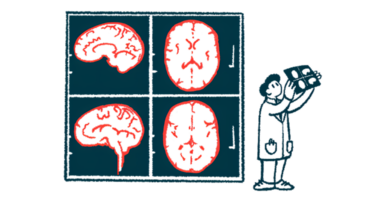Relapses, lesions in 1st year on oral DMT seen to help predict outcomes
MAGNIMS scoring system found to forecast worse disability in RRMS

A scoring system that accounts for relapses and MRI activity in multiple sclerosis (MS) patients during their first year on an oral disease-modifying therapy (DMT) was found to be predictive of worse short-term outcomes for people with relapsing forms of the neurodegenerative disorder, a study showed.
“The occurrence of either at least one relapse or substantial MRI activity … in the first year of oral treatment should advise neurologists to consider an escalation strategy,” the researchers wrote.
The system originally was developed within the MRI in Multiple Sclerosis (MAGNIMS) network — a European network of researchers who collaborate on studies involving the use of MRI in MS. There it was used to predict outcomes for MS patients using injectable treatments. Now, the scoring system was found to also forecast disability worsening, treatment failures, and relapse burden for patients with relapsing-remitting multiple sclerosis (RRMS) after three years on oral therapy.
“Data showed here support the use of the scoring system developed within the MAGNIMS network in patients treated with oral DMTs,” the researchers wrote.
The study, “Assessing treatment response to oral drugs for multiple sclerosis in real-world setting: a MAGNIMS Study,” was published in the Journal of Neurology, Neurosurgery & Psychiatry.
Testing the MAGNIMS scoring system on DMT outcomes in relapsing MS
RRMS patients, for whom disease relapses are interspersed with periods of remission, require routine monitoring to assess DMT responses and adjust therapeutic regimens accordingly. Scoring systems to predict treatment responses could help clinicians make appropriate therapeutic decisions.
The MAGNIMS scoring system takes into account relapses and brain lesions in the first year on treatment. It was validated to predict responses to the injectable MS DMT interferon beta — therapies such as Rebif (interferon beta-1a) and Betaseron (interferon beta-1b).
Now, the scientists aimed to apply the scoring system to predict short-term outcomes among relapsing MS patients starting on an oral DMT. Their study involved 1,200 adults with RRMS, ages 18-65, starting oral DMTs at MS clinics in Europe within the MAGNIMS network.
Altogether, 598 patients were treated with Tecfidera (dimethyl fumarate), 308 with Gilenya (fingolimod), and 294 with Aubagio (teriflunomide); these were the oral therapies approved for prescription in Europe at the time of the study. The patients may or may not have previously received an injectable therapy.
The MAGNIMS scoring system divides patients by risk level according to the presence of clinical relapses and MRI lesions in their first year on the therapy.
Patients without relapses and fewer than three new brain lesions are classified as having a low risk, while those with one relapse or three or more new brain lesions have a medium risk. Those with either one relapse and at least three brain lesions, or two or more relapses have a high risk.
According to this stratification, 1,008 patients were deemed to have a low risk, 162 a medium risk, and 30 a high risk.
Three years after starting the DMT, participants were assessed for six-month confirmed disability worsening. These assessments were based on the Expanded Disability Status Scale (EDSS), the number of relapses in the two prior years, and treatment failure — the need to switch treatment due to lack of efficacy.
Overall, 13% of participants experienced confirmed disability worsening, and treatment failure occurred in 20%.
The risk of disability worsening was significantly higher in patients in the medium-risk group — by nearly twofold — and in the high-risk group, by nearly three times, relative to those with low risk by the MAGNIMS scoring.
Similarly, patients in the medium- and high-risk groups had a nearly three to five times higher risk of treatment failure than those in the low-risk group.
Overall, the MAGNIMS system showed a 77% accuracy in identifying patients at risk of confirmed disability worsening and of treatment failure.
While most participants did not experience any relapses in the two previous years, 13.9% had one relapse, 2% had two relapses, and 0.7% had three or more. Again, patients in the two higher risk groups were found to have a significantly higher relapse count, by up to three times, than patients in the low risk group.
Consistent findings were observed for each of the treatment groups.
MAGNIMS scoring system could use some improvements, researchers say
The researchers noted that the MAGNIMS system could still stand to improve its sensitivity, or its ability to correctly identify patients who would have a poor outcome later on.
“The relevant number of false negatives, that is, patients experiencing [confirmed disability progression] and [treatment failure] despite a low risk score, might be related to progression independent of relapse activity (PIRA) events,” the researchers wrote.
Additional analyses indicated that also considering the location of new lesions in the scoring system could further improve its prediction accuracy for disability worsening in the low-risk group.
Specifically, the development of new lesions in a region in the lower part of the brain or in the spinal cord significantly increased the risk of disability worsening by about twofold for these patients.
Moreover, the presence of active inflammatory lesions was found to significantly increase, by about two times, the risk of treatment failure and the chances of experiencing a higher number of relapses in this patient subgroup.
“Our findings suggest also that the MAGNIMS score might be refined by considering the presence of [active inflammatory lesions] and lesion location in patients with minimal MRI activity alone,” the team wrote.
Clinicians can rely on early relapses and MRI activity in the first year of treatment with oral DMTs to prevent the accrual of short-term confirmed disability worsening through the optimization of treatment choices.
Overall, these findings suggest “clinicians can rely on early relapses and MRI activity in the first year of treatment with oral DMTs to prevent the accrual of short-term confirmed disability worsening through the optimization of treatment choices,” the researchers wrote.
For patients experiencing relapses or substantial MRI activity during their first year of treatment, a treatment escalation strategy may be warranted, the team noted.
“Biomarkers of treatment response other than focal inflammation, as detected with the currently available conventional MRI scans, represent a future avenue for researching predictors of silent progression,” the researchers concluded.








